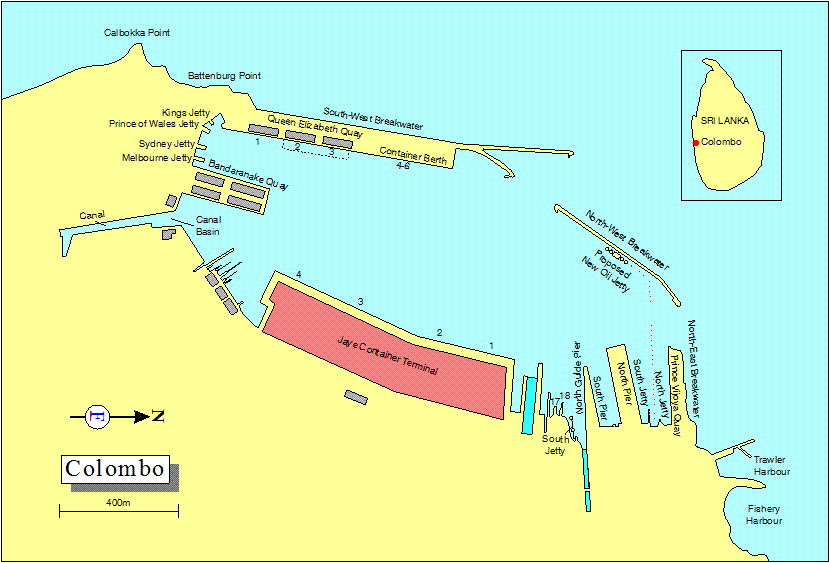Port of Colombo description
Odessa National Maritime Academy
English language department
Sailing practice report
c/v CMA CGM KALAMATA
Done by cadet of group 1141 Shamray A.
Checked by Primina N.
Odessa 2008
Contents
1.Description of port visited during the sailing practice.Description of port from navigational point of view(lights,tides,navigational dangers,bouyage)
2.Port regulations of port visited.
3.Pilot embarcation,anchoring and mooring operation description.
4.Clearing in and out procedures and documents required.
5.Example of VHF conversation at sea.
6.Examples of OOW’s professional situations when on bridge with the use of VHF equipment.
7.Procedure and real runniing of fire,survival crafts and abandon ship drills.
Port of Colombo description
Location: Colombo lies on the W coast of Sri Lanka and is the country's principal city and port. Its geographical location straddles the major sea routes between W and E.
General overview: A total port area of 201.5ha is enclosed by breakwaters and 2 entrances provide access.
A major container trasshipment port. The main imports are crude oil, machinery, iron and steel and manufactured goods; exports include sawn timber, crude rubber, machinery, textiles and manufactured goods.
Traffic figures: Approx 28,200,000t of cargo, 1,960,000teu and 3,800 vessels are handled annually.
Load Line zone: Tropical.
Max size: LOA 300m, draft 14m.
Largest vessel handled: "President Truman", container vessel, 54,700dwt.
Navigation in port of Colombo
Port limits: The port limits extend 6nm offshore and approx 2nm N and S of the W entrance.
Sea buoys, fairways and channels: The W entrance between the SW and NW breakwaters, has approx width of 250m and is dredged to 13m. There is a dredged channel with 15m depth, 1.0nm length and a min width of 300m. The channel is buoyed. There is a turning basin inside, dredged to 14m depth at MLWS.
There is a disturbed swell across the entrance during the SW monsoon. The recommended approach course under these conditions is 145°.
The N entrance between NW and NE breakwaters has an approx width of 200m, with a limiting depth of 10.5m in the approaches.
Pilot: Pilotage is compulsory for all merchant vessels except those exempted by the Harbour Master. Available 24 hours.
Requests for pilots, stating the ship's ETA, should be made 24 hours prior to arrival, with later corrections to the ETA if necessary.
A vessel intending to enter the harbour should contact the pilot station on Ch 16.
To facilitate embarkation of the pilot, a vessel should, unless previously intercepted by the pilot launch, pick the pilot up approx 2nm NW of the SW breakwater Lighthouse. Until boarded by a pilot, no vessel should approach closer to the port than this position, unless requested to do so.
All vessels to call Colombo Port Control (CPC) on VHF Ch 16 to advise ETA and vessel's details when within VHF range and to follow CPC's instructions for anchorage or pilotage.
The following provisions should be made to assist the pilot boarding:
A pilot ladder should be rigged on the lee side, 1.5m above the water level.
Two man ropes of at least 3in diameter rope, with the lower ends free, to be hung from the vessel's rail. A combination ladder is required when the pilots climb is more than 9.0m.
Colombo Port Control is equipped with a modern radar monitoring system, listening Ch 16.
By night, a bright light to be shown midway between rail and water to indicate the position of the ladder and man ropes.
In vessels of high freeboard fitted with gangway doors, the lee gangway door to be opened and the ladder and man ropes hung from there.
In the event of the weather conditions being such as to preclude the vessel being boarded by a pilot outside the harbour the appropriate signals will be displayed at the pilot station. The vessel may, at the discretion of the Harbour Master, be given the option of proceeding into harbour and picking up the pilot inside, the vessel being instructed by signal whether to run in or stand off. The option to enter is not given at night, under normal circumstances. Vessels waiting to enter should remain under way as convenient, well clear of both entrances.
A vessel intending to leave harbour should make one of the signals for a pilot 30 minutes before ready to set sail and call Colombo Port Control on Ch 16. In normal circumstances the pilot will leave an outgoing vessel as it passes the pilot station.
Anchorages: Anchorages are available, W and N of the port clear of cables and SPM restricted areas. The following anchorages are available:
1. Container vessels: 06°56.0'N to 06°57.5'N
079°44.0'E to 079°45.5'E
2. Repair vessels: 07°00.0'N to 07°02.0'N
079°45.0'E to 079°49.0'E
Tidal range and flow: Range Springs 0.6m, Neaps 0.2m
Dock density: 1025
Weather: Prevailing winds: SW'ly and NE'ly monsoon.
Principal navigation aids:
Colombo Lighthouse "Galbokka".
Monument (82m high) (06°56.3N 079°50.5E)
Ratmalana RDF beacons.
Charts: BA 1655. Admiralty Pilot NP38, NP286(4).
Restrictions: Vessels under sail may only enter between 0600-1800hrs. Other vessels, no such restriction.
Tugs: Tugs of 1,500-3,500hp range are available from Sri Lanka Ports Authority (3 tugs of 45t bollard pull available).
Divers available.
Bunkers/water/stores: Fresh water: Available.
Bunkering: Marine fuel, gas and diesel oils available by barge at all berths. A wide range of lubricants is also available. Bunkering also available at anchorage.
Medical facilities: Colombo General, 3km. Medical centre located in the port.
Transport: Nearest airport: Colombo International, 29km.
Airport facilities: Crew change and airfreight facilities available.
Nearest railway: Colombo port, 0.5km.
Public holidays: Sinhalese & Tamil New Year's Day, May Day, Wesak Full Moon Poya Day and Christmas Day.
Working hours: Normally 0730-1630hrs and 1630-0400hrs (possibly extended to 0600hrs).
Developments: Short and long term development programmes are in progress in order to maintain the port's present position as a major Hub-Port in the region.
Colombo South Harbour Development Project. Construction of new breakwater and container berths. Initial stage 3km breakwater and dredging of 6 berths.
Pollution: Vessels held responsible for clean up, Harbour Master to be informed immediately.

Port of Colombo plan